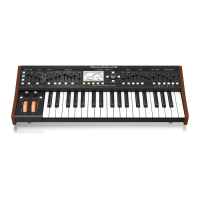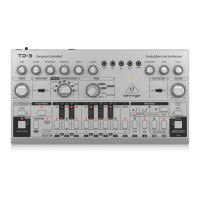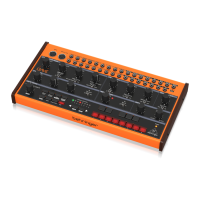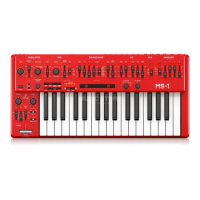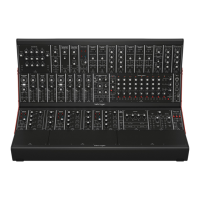55 DeepMind 12 User Manual
8.1.8 EDIT CTRL SEQUENCER
The CONTROL SEQUENCER allows you to create a pattern which can be used to
modulate other parameters. This section covers in detail all the parameters
related to the CONTROL SEQUENCER.
For more information on using the CONTROL SEQUENCER as a modulation source,
please consult the MOD MATRIX section later in this document.
When a control sequence is created and saved, it is saved to the current preset. So
each of the presets may have its own control sequence.
A good way to learn about the control sequencer is to choose a program that is
using the sequencer. (The text "SEQ" will be highlighted in white at the top of the
program display.) Then press the MOD switch to see which destination the control
sequence is modulating. In the CTRL SEQUENCER menu described below, you can
then adjust the parameters as you play notes on the keyboard, and you will hear
the dierences.
1. To enter the EDIT page for the ARPEGGIATOR and CONTROL SEQUENCER, press
the EDIT switch in the ARP/SEQ section.
In the ARP/SEQ EDIT menu there are three pages; this section covers the
CONTROL SEQUENCER menu. To cycle through the pages, use consecutive
presses of the EDIT switch. The bottom line of the screen will show guidance
to the next page.
2. To access the CONTROL SEQUENCER menu directly, you can press the ARP/SEQ
EDIT switch twice. The CONTROL SEQUENCER menu will then appear:
3. To navigate the options in the CONTROL SEQUENCER menu, use the BANK/UP
or BANK/DOWN switches.
4. Selected parameters are adjusted using the -/NO or +/YES switches, the
rotary knob or the DATA ENTRY fader. The rotary knob has a click which
allows very accurate control. The fader allows rapid adjustment across the
full range.
• ENABLE - This option turns the CONTROL SEQUENCER function On or O.
• CLOCK DIVIDER - This option allows you divide the Master BPM in a number
of ways to produce the CONTROL SEQUENCER CLOCK. You can select any of the
options from the following table:
Note: For a timing diagram please consult the section later in this
document.
FLASHING=EDIT
RATIO DESCRIPTION
4 Four notes
3 Three notes
2 Two notes
1 One note
½ Half note
⁄ Dotted quarter note
⁄ Third note (Half note triplets)
¼ Quarter note
⁄ Dotted eighth note
⁄ Sixth note(Quarter note triplets)
⁄ Eighth note
⁄ Dotted sixteenth note
⁄ Twelfth note (Eighth note triplets)
⁄ Sixteenth note (the Default value)
⁄ Dotted thirty-second note
½ Twenty-fourth note (Sixteenth note triplets)
⁄ Thirty-second note
⁄ Dotted sixty-fourth note
¼ Forty-eighth note (Thirty-second note triplets)
⁄ Sixty-fourth note
The default value is 1/16th note.
Note: When the SUSTAIN input is set to any of the GATE modes in the PEDAL
SETTINGS the value will be replaced by "(Gate)" to indicate that the CLOCK
DIVIDER is not used and the CONTROL SEQUENCER steps are controlled by the
GATE input.
• LENGTH - This option allows you to adjust the length (number of steps) of
the CONTROL SEQUENCE from 2 to 32. This can also be adjusted within the
SEQUENCE EDITOR.
The default value is 6.
• SWING - This option allows you to adjust the swing (or groove) of the
CONTROL SEQUENCER.
When applying SWING, every other step is delayed by an amount set by
the swing value. The swing value represents the ratio of time between two
steps. For example, when the swing is at 50%, there will be equal timing
between the steps. To adjust the SWING timing to fall where a triplet would,
set the SWING to 66%.
You can use the SWING parameter to add a timing element which can
help create propulsive rhythms, or laid back styles which can help give the
sequence of notes movement, or allow it to breath, or make room for other
parts of the mix.
The SWING RATE range is from 50 to 75. The default SWING value is 50.
Note: When the SUSTAIN input is set to any of the GATE modes in the PEDAL
SETTINGS the value will be replaced by "(Gate)" to indicate that the SWING
is not used and the CONTROL SEQUENCER steps are controlled by the GATE
input.
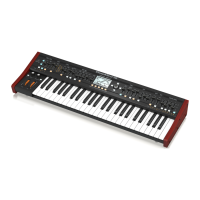
